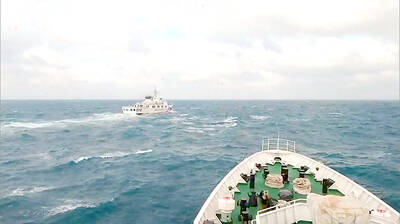Following a formal investigation that has continued for nearly two years, a final report by a special task force under the Civil Aviation Administration has concluded that pilot error -- as has long been expected -- was behind the crash of China Airlines flight 676 at CKS International Airport in Taoyuan in February, 1998, that killed all 196 people on board and six others on the ground.
The investigation into the crash has centered around orders from the control tower to the plane to abort its first landing attempt, and to "go around" for a second landing.
The investigation found that the pilot had released the plane's autopilot but was not aware of it, and the procedures taken for the second landing attempt were erroneous.
The Civil Aeronautics Administration will submit the bilingual report, which runs up to several hundred pages, to the Ministry of Transportation and Communications. A formal announcement of its results will be made in about a month's time.
The reports says the plane's pilot failed to correct an error in the plane's altitude during the landing approach, despite warnings from the control tower that the aircraft was more than 1,000 meters above its normal altitude when it was only six nautical miles away from the airport.
The report also pointed out that before the plane hit the ground, it was locked in autopilot mode, but that when it started to dip, it was turned to manual control. The investigation group said these facts led them to conclude that as the Airbus A300 was preparing to land, the pilot mistakenly believed the aircraft was on autopilot.
When he received the order to "go around," he therefore did nothing to actively take control of the plane. For 11 seconds, the report says, the plane was under no one's control.
The report concludes by pointing the finger at China Airlines for what it calls "insufficient training" and "poor management of the resources in the pilot's cabin".
Flight 676 had been returning from the Indonesian resort of Bali, where, among other passengers, then-Central Bank governor Sheu Yuan-dong (
In the nearly two years since the crash, speculation has continued about the possible role of pilot error. As early as the day after the crash, airline industry analysts and other sources cast doubt on the possibility that it was caused by mechanical failure.
They cited the fact that there had been no obvious mechanical failure before impact, evident in the pattern of wreckage and the pilot's conversation with the flight control tower.
The plane plowed into a row of apartment buildings not too far from the runway, and then broke into several pieces. Experts have said that if the pilot had lost control, the aircraft would have crashed over a wider swath of land.

Auckland rang in 2026 with a downtown fireworks display launched from New Zealand’s tallest structure, Sky Tower, making it the first major city to greet the new year at a celebration dampened by rain, while crowds in Taipei braved the elements to watch Taipei 101’s display. South Pacific countries are the first to bid farewell to 2025. Clocks struck midnight in Auckland, with a population of 1.7 million, 18 hours before the famous ball was to drop in New York’s Times Square. The five-minute display involved 3,500 fireworks launched from the 240m Sky Tower. Smaller community events were canceled across New Zealand’s

The Ministry of Foreign Affairs (MOFA) yesterday said it is closely monitoring developments in Venezuela, and would continue to cooperate with democratic allies and work together for regional and global security, stability, and prosperity. The remarks came after the US on Saturday launched a series of airstrikes in Venezuela and kidnapped Venezuelan President Nicolas Maduro, who was later flown to New York along with his wife. The pair face US charges related to drug trafficking and alleged cooperation with gangs designated as terrorist organizations. Maduro has denied the allegations. The ministry said that it is closely monitoring the political and economic situation

‘SLICING METHOD’: In the event of a blockade, the China Coast Guard would intercept Taiwanese ships while its navy would seek to deter foreign intervention China’s military drills around Taiwan this week signaled potential strategies to cut the nation off from energy supplies and foreign military assistance, a US think tank report said. The Chinese People’s Liberation Army (PLA) conducted what it called “Justice Mission 2025” exercises from Monday to Tuesday in five maritime zones and airspace around Taiwan, calling them a warning to “Taiwanese independence” forces. In a report released on Wednesday, the Institute for the Study of War said the exercises effectively simulated blocking shipping routes to major port cities, including Kaohsiung, Keelung and Hualien. Taiwan would be highly vulnerable under such a blockade, because it

UNRELENTING: China attempted cyberattacks on Taiwan’s critical infrastructure 2.63 million times per day last year, up from 1.23 million in 2023, the NSB said China’s cyberarmy has long engaged in cyberattacks against Taiwan’s critical infrastructure, employing diverse and evolving tactics, the National Security Bureau (NSB) said yesterday, adding that cyberattacks on critical energy infrastructure last year increased 10-fold compared with the previous year. The NSB yesterday released a report titled Analysis on China’s Cyber Threats to Taiwan’s Critical Infrastructure in 2025, outlining the number of cyberattacks, major tactics and hacker groups. Taiwan’s national intelligence community identified a large number of cybersecurity incidents last year, the bureau said in a statement. China’s cyberarmy last year launched an average of 2.63 million intrusion attempts per day targeting Taiwan’s critical